We first encountered the SAPA (South American Parade Addiction) back in Puerto Lopez, a little town on the coast of Ecuador. We just happened to be passing through on the day of the Festival of Humpback Whales, kicking off the start of the town´s whale-watching season. It was all very innocent, just a small-town parade consisting of cars decorated like whales, and schoolchildren performing traditional dances and dressing up as shrimp and the like. Cute.


(By the way.... it is worth noting that the Spanish word for whales sounds almost exactly like the Spanish word for virgens. Also, the Spanish word for parade is desfile. A great deal of confusion resulted when Cristobal [that guy whose house we tented at] was trying to tell me about the parade of whales, but he didn´t know the English word for parade. He not only accidentally spelled desfile ¨defile¨, but he looked it up in the English section of his dictionary and showed me the definition. Thus, there was a period of time was I was sure he was telling me the we were in town for the annual Festival of the Defiling of Virgens. I was glad to get that straightened out.)
Moving on... the next day, we had made it as far as Piura, Peru. I had left Nic guarding our backpacks on a bench in a tranquil town square while I investigated ATMs. While I was gone, what should come marching around the corner....

Nic got kicked out of his bench on the park to make way for some sort of military academy ceremony, and had to drag both our bags across the street on his own. I got back in time to enjoy the show, which involved marching bands, soldiers in combat fatigues, homecoming princesses, and what appeared to be a previous graduating class of the academy:

Note the one guy who missed the memo about which tie to wear.
The exact same thing happened a few days later... I was to meet Nic in the middle of the main square in Cusco, but as he was waiting he got kicked out, this time by a squad of Incan guards:
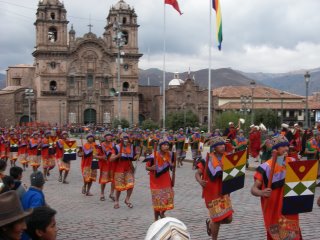
Then things really started to get out of hand.
It seems that as the Spaniards conquered their way across South America, they encountered a certain Incan tradition. Each year, the townspeople would bring out the mummies of all their deceased kings and gleefully parade them around town. The Spaniards, understandably perturbed at the sight, somehow convinced the natives to parade around effigies of the Catholic saints instead of the bodies of their dead Incan kings. The tradition survives today as Corpus Christi... and all week in Cusco we´ve had to side-step marching bands and throngs of people parading their particular effigy around the streets before returning it to its home church.

We also happened to show up in Cusco in time for Cusco Week, which seems to be mainly celebrated by setting of generous amounts of firecrackers (all week, at all hours) and, of course, parades. One morning around 9 we stumbled upon the beginning of the Cusco Week parade.

We enjoyed it for a while, chuckled at our luck at finding parades, and went about our day. We got back to the square that night a little after 11... and were stunned to see the last entry, number 196, pass the judging stands.

It had been a fifteen hour parade. These guys take their parades seriously.
Cusco Week ended with Inti Raymi, a reinactment of an Incan winter solstice ceremony. It started in the town square:

Papa Inca. The main dude. Our personal favorite.
Then the entire audience marched up the hill to the nearby Incan ruins of Sacsayhuaman.

(Note: Sacsayhuaman is pronounced exactly like ¨sexy woman.¨This makes for interesting conversations... for example, overheard in the streets of Cusco: ¨So, did you enjoy sexy woman today?¨)
After a few hours of waiting for the thousands of people to find their way to the ruins and get seats on the hillsides, we were treated with a rambling ceremony consisting of a series of strangely famiar dances (we´d seen them all half a dozen times already), garbled native music blasted through the traditional Incan sound system, and lots of shouted Quechua. (The native Incan language, which almost no one understands. It was nice, for once, not to be the only one out of the loop.)
It both rained and hailed during the Incan sun-worship ceremony. Something´s wrong, here.
Oh yeah. They also killed a llama. Yup. Right in front of us. Killed it, pulled out its guts and still-beating heart, and burned them. That was right between the pretty handkerchief dance and the twirling maiden dance.
Our last night in Cusco, we´d had enough of parades. We took our tent, got on a bus, and found a secluded hillside overlooking the valley.
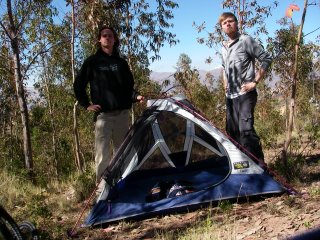 There, we were lulled to sleep by the sounds of native Andean wildlife: birds, sheep, llamas... and, to our astonishment and horror, echoing from miles away, the unmistakable revelry of yet another Peruvian parade.
There, we were lulled to sleep by the sounds of native Andean wildlife: birds, sheep, llamas... and, to our astonishment and horror, echoing from miles away, the unmistakable revelry of yet another Peruvian parade.







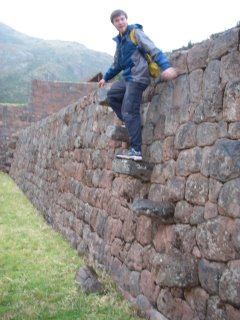





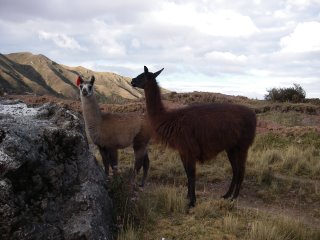









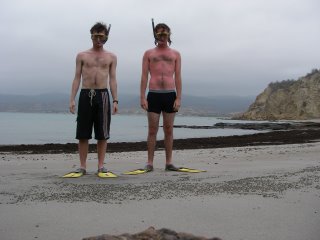







 One more shot of Quito, before we head off for the coast... notice the pleasant park with pleasant artist selling their pleasant wares at left, the big city-type things at right, and the mountainous mountains with their mountain-ish clouds in the immediate background. Ah, Quito... how radical you are.
One more shot of Quito, before we head off for the coast... notice the pleasant park with pleasant artist selling their pleasant wares at left, the big city-type things at right, and the mountainous mountains with their mountain-ish clouds in the immediate background. Ah, Quito... how radical you are.





